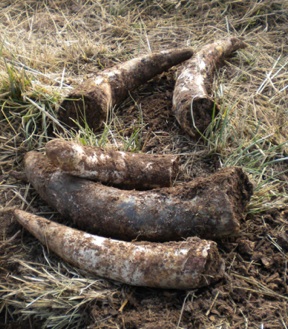Wine Celebrates “The International Day of Poo”
 Winemakers and grapegrowers across the globe are celebrating what might kindly be called "The International Day of Poo". Today, the Autumnal Equinox, is the the day that biodynamic grape growers are called upon to undertake "Preparation 500".
Winemakers and grapegrowers across the globe are celebrating what might kindly be called "The International Day of Poo". Today, the Autumnal Equinox, is the the day that biodynamic grape growers are called upon to undertake "Preparation 500".
Preparation 500 is the act of taking a steer horn, stuffing it with steer manure, burying it in the vineyard for six months, digging it up on the Spring Equinox six months later, then diluting the "mixture" and spraying the vineyard with it.
Stu Smith, author of of the blog Biodynamics Is a Hoax has a timely post up on his blog about what I like to call "The International Day of Poo". Entitled "Why Today is Different From All Other Days", the article investigates the origins of "Preparation 500" according to Rudolph Steiner and has some choice commentary on the practice and what it means.
The post and the Biodynamics Is A Hoax blog is highly recommended.
Since I don't have a vineyard, it will be difficult for me to properly celebrate the International Day of Poo. However, I will "use the facilities" later and think about biodynamics.

I don’t know much about BioDynamnics–for a reason. Aside from believing that doing well by planet earth is a good thing, I would rather taste wine than evaluate winegrowing options.
You make it. I taste it. Don’t lecture me. Just let me taste the wine blind. That’s what I do, and, frankly, I don’t see great hedonistic benefits to BioD. If it makes the soil more alive, well fine. If that makes you happy, well fine.
The New York Cork Report is running a series of articles about BioD and using real studies, not arguments for or against BioD as its basis for judgment. I commend it to anyone interested in the subject. Of course, if you are agnostic on the subject or a total disbeliever, you will find the earnest prose of Stu Smith to be the funniest wine read on the Internet since Ron Washam hung up his keyboard and headed for the hills.
I tend to agree with Mr. Olken’s abstract way of evaluating product quality.
That said, I also would prefer to withhold judgment upon some of the metaphysical claims apparent in the oratory cited at professor Smith’s website. Managing a vineyard in the Delta might produce theologic visions but those would be incidental to the business of raising winegrapes there, as prof Smith likely would agree.
As for the bovine horn for keeping the powder dry or for production of composted soil amendments, it seems rather quaint, so I will agree with Smith et al; additionally, I would add for the benefit of people practicing bioDynamix but still searching for horns, that the scarcity is part of modern livestock management, as, for safety and health reasons, cattlemen, an occupation in which I have served, prefer polled animals, i.e., cows without horns; see there:
http://www.ansi.okstate.edu/breeds/cattle/redangus/
An article describing conditions before polling became common appears there:
http://www.chisholmtrailmuseum.com/chisholmtrail_map_lg.php
Included in the latter is a map of a 1,000 mile long cattle drive trail web along which perhaps one might, this day, still find a few horns.
Thanks for this, very interesting post.